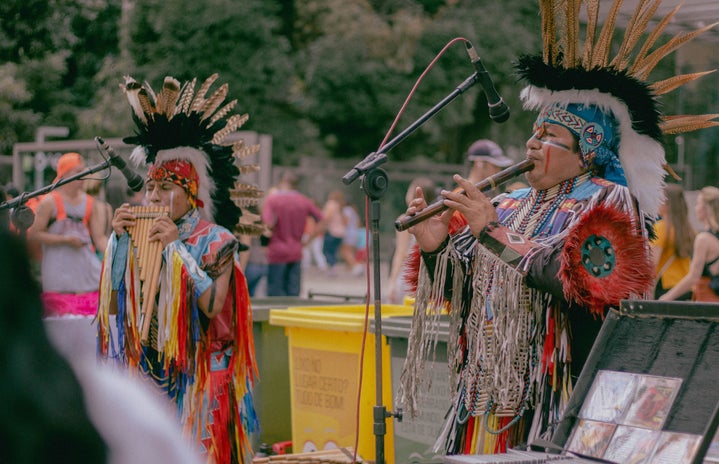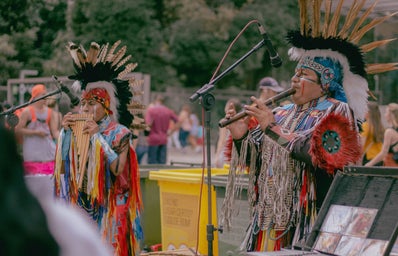Today, we celebrate the people who first called this land home. We remember the struggles and tragedies they endured. We honor their place in and contributions to the shared story of America. Thousands of Indigenous children suffered and died in residential schools around the world. To date, their cries echo through the hidden crevices of history.
Between 1890 and 1978, at Kamloops Indian Residential School in the Canadian province of British Columbia, thousands of Indigenous children were taught to forget. Separated from their families, these children were compelled to forget their languages, their identities, and their cultures. Through separation and forgetting, settler governments and teachers believed they were not only helping Indigenous children but the nation itself. Canada would make progress, settlers claimed, if Indigenous children could just be made more like white people. In the early 20th century Kamloops Indian Residential School expanded, and a complex of redbrick buildings was constructed to accommodate an increase in students. Today, the redbrick buildings are still standing on the Tk’emlúps te Secwépemc First Nation’s land. You can still look through the glass windows and see the old classrooms and halls. You can walk the grounds, toward the site of the former orchard or the banks of the nearby river. And you can stand over the graves of 215 children who died right here, at Kamloops Indian Residential School.
Some never even saw their fourth birthday.
You might think the Kamloops ‘school’ and its unmarked graves are an isolated and regrettable part of Canadian history, which we have now moved beyond. But that is a lie. Those 215 graves are part of a much larger political project that continues to this day. When the burial sites at Kamloops were identified in May 2021 using ground-penetrating radar, news of the ‘discovery’ spread through international media. First-hand accounts of former students and Indigenous community members began to spread, too, and it soon became clear to the wider world that the ‘discovery’ was a confirmation of what Indigenous peoples in Canada had known for generations. The testimonies from survivors and their descendants were met with expressions of shock and disbelief from white Canadians: “how could this have happened? Why didn’t we know anything about this?” But the knowledge was no secret. It was publicly available in institutional records; it was in the testimonies of Indigenous peoples, and it was in 20th-century reports made by government officials. They didn’t just choose to forget, they participated in a grand project of forgetting. The records are there, filled with the stories of those left to drown in the wake of settler colonization. So, what does that say for our apparent ‘shock’? What does our ‘surprise’ really mean?
These questions become more confronting when we accept that abuses didn’t take place just in the dim and distant past. Consider this testimony from 1998 of Willie Sport who was a student, in the 1930s, of Alberni Indian Residential School in British Columbia:
I spoke Indian in front of Reverend Pitts, the principal of the Alberni school. He said: ‘Were you speaking Indian?’ Before I could answer, he pulled down my pants and whipped my behind until he got tired. When I moved, he put my head between his knees and hit me harder. He used a thick conveyor belt, from a machine, to whip me.
Willie Sport (former student at Alberni Indian Residential School in British Columbia)
That Principal Pitts wanted to kill people like us. He wouldn’t tell parents about their kids being sick and those kids would die, right there in the school. The plan was to kill all the Indigenous people they could, so Pitts never told the families that their kids had tuberculosis. The revelation of the burial sites at Kamloops and the ensuing ‘shock’ of non-native Canadians shows that forgetting – in the form of unlearning, concealment, or deception – is an integral part of the very system that killed those children and erased them from settlers’ memories. This forgetting is nothing new. It has been part and parcel of the European colonial project for centuries. It has once enabled such endeavors, as the ‘discovery’ and ‘claiming’ of territory, the physical slaughter of Indigenous populations, and the attempts to forcibly assimilate Indigenous peoples by indoctrinating their children into residential institutions. However, deception has been used against European populations, too; the forgetting that accompanies forced assimilation goes both ways.
When frameworks for dispossession become entrenched through educational, social and political systems, settler states can compel their citizenry to ‘forget’ the horrors of colonization, to deny that these things ever happened, and to aggressively demand that others join them in this deliberately cultivated collective ‘amnesia’. Take India for example.
Settler ‘forgetting’ isn’t just a lapse in memory. It inherits an older impulse: the intentional annihilation of Indigenous knowledge systems. It’s epistemicide.
Indigenous children around the world faced similar experiences, including Māori children in New Zealand; Aboriginal and Islander children in Australia and the Torres Strait Islands; Sámi, Inuit and Kven children in the Nordic countries; and Native children in the United States, among others. Their soul was damaged. These are the most barren and fruitless of learning years. They were wasted, so to speak, and a wasted childhood can never be made good. The ‘kill the Indian, save the man’ dictum (as it became known) was positioned as philanthropic at the time because it seemed to mark a seemingly progressive transition from the policy of killing to ‘saving’ through educative assimilation. Who better than us Indians can know the impact of imperialist superiority, a collective ideology that left entire communities in broken spirits, and led to famines, poverty, and cultural dissipation across continents?
Our early ancestors thought that the white man knew what was best for Indigenous children – better than their own families and communities – and what was ‘best’ was assimilation, against which the ‘contaminating’ influences of family, culture and tradition were held at bay. Today, some might wonder why separating children from their families and cultures could have seemed like a good idea as recently as a century ago. We forget that these practices of separation and forgetting weren’t incidental, or historical accidents. Instead, they were deliberate acts of expunction, disguised under the labels of progressive and philanthropic.


